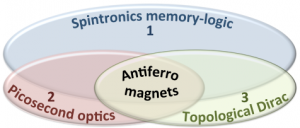The aim of the project is to open and explore a new research avenue, with emerging and future information technologies at its horizon, where antiferromagnets take the center stage. Antiferromagnets and ferromagnets represent two fundamental forms of magnetism with antiferromagnets being the more abundant of the two. However, it has been notoriously difficult to manipulate and detect antiferromagnetic order by any practical means due to the compensated magnetic moment. This has left antiferromagnets over their hundred-year history virtually unexploited and only poorly explored, in striking contrast to the thousands of years of fascination and utility of ferromagnets. The project builds on our very recent discovery of a new relativistic spin-torque phenomenon that allow us to efficiently control antiferromagnetic moments in spintronic devices and by this to unlock a multitude of known and newly identified unique features of this “dormant-giant” class of materials.
 We explore three intertwined research areas in order to scientifically establish to following: (i) The concept of antiferromagnetic memory-logic suitable for the development of future “Beyond Moore” Internet of Things technologies. Here the unique added value of compensated antiferromagnetic moments is that they allow for combining endurance, non-volatility, and radiation-hardness with magnetic insensitivity and invisibility of processed and stored data, with high packing density, and with enhancing capacity and integrating logic in multi-level (neuron-like) bit cells. (ii) The concept of antiferromagnetic memory-logic components operating at timescales as short as picoseconds. Here we will exploit the THz-limit of antiferromagnetic dynamics in combination with our relativistic spin-torque approach to excite the antiferromagnet. (iii) The concept in which antiferromagnets provide a unifying platform for realizing synergies among three prominent fields of contemporary condensed matter physics, namely spintronics, Dirac quasiparticles, and topological phases. Here spintronic devices made of antiferromagnets with their unique symmetries will allow us to control the emergence and to study the properties of Dirac/Weyl fermion topological phases that are otherwise principally insensitive to external stimuli. In return, the resulting topological magneto-transport phenomena open the prospect of new, highly efficient means for operating the antiferromagnetic memory-logic devices.
We explore three intertwined research areas in order to scientifically establish to following: (i) The concept of antiferromagnetic memory-logic suitable for the development of future “Beyond Moore” Internet of Things technologies. Here the unique added value of compensated antiferromagnetic moments is that they allow for combining endurance, non-volatility, and radiation-hardness with magnetic insensitivity and invisibility of processed and stored data, with high packing density, and with enhancing capacity and integrating logic in multi-level (neuron-like) bit cells. (ii) The concept of antiferromagnetic memory-logic components operating at timescales as short as picoseconds. Here we will exploit the THz-limit of antiferromagnetic dynamics in combination with our relativistic spin-torque approach to excite the antiferromagnet. (iii) The concept in which antiferromagnets provide a unifying platform for realizing synergies among three prominent fields of contemporary condensed matter physics, namely spintronics, Dirac quasiparticles, and topological phases. Here spintronic devices made of antiferromagnets with their unique symmetries will allow us to control the emergence and to study the properties of Dirac/Weyl fermion topological phases that are otherwise principally insensitive to external stimuli. In return, the resulting topological magneto-transport phenomena open the prospect of new, highly efficient means for operating the antiferromagnetic memory-logic devices.
 Our very recent achievements, including the demonstration of a USB proof-of-concept antiferromagnetic memory, make Europe the birthplace of the emerging field of antiferromagnetic spintronics. To contribute in a decisive way to assuring that the future science and technology impact of the field remains in Europe, this project brings together a critical mass of academic and SME partners covering all the necessary multidisciplinary skills and expertise.
Our very recent achievements, including the demonstration of a USB proof-of-concept antiferromagnetic memory, make Europe the birthplace of the emerging field of antiferromagnetic spintronics. To contribute in a decisive way to assuring that the future science and technology impact of the field remains in Europe, this project brings together a critical mass of academic and SME partners covering all the necessary multidisciplinary skills and expertise.
Participating PIs
-
- Tomas Jungwirth (coordinator) (IOP-Prague)
- Kevin Edmonds (Nottingham)
- Stuart Parkin (MPI-Halle)
- Tobias Kampfrath (MPI-Berlin)
- Claudia Felser (MPI-Dresden)
- Jairo Sinova (JGU-Mainz)
- Mathias Kläui (JGU-Mainz)
- Xavier Marti (IGS)
- Petr Nemec (CU-Prague)
